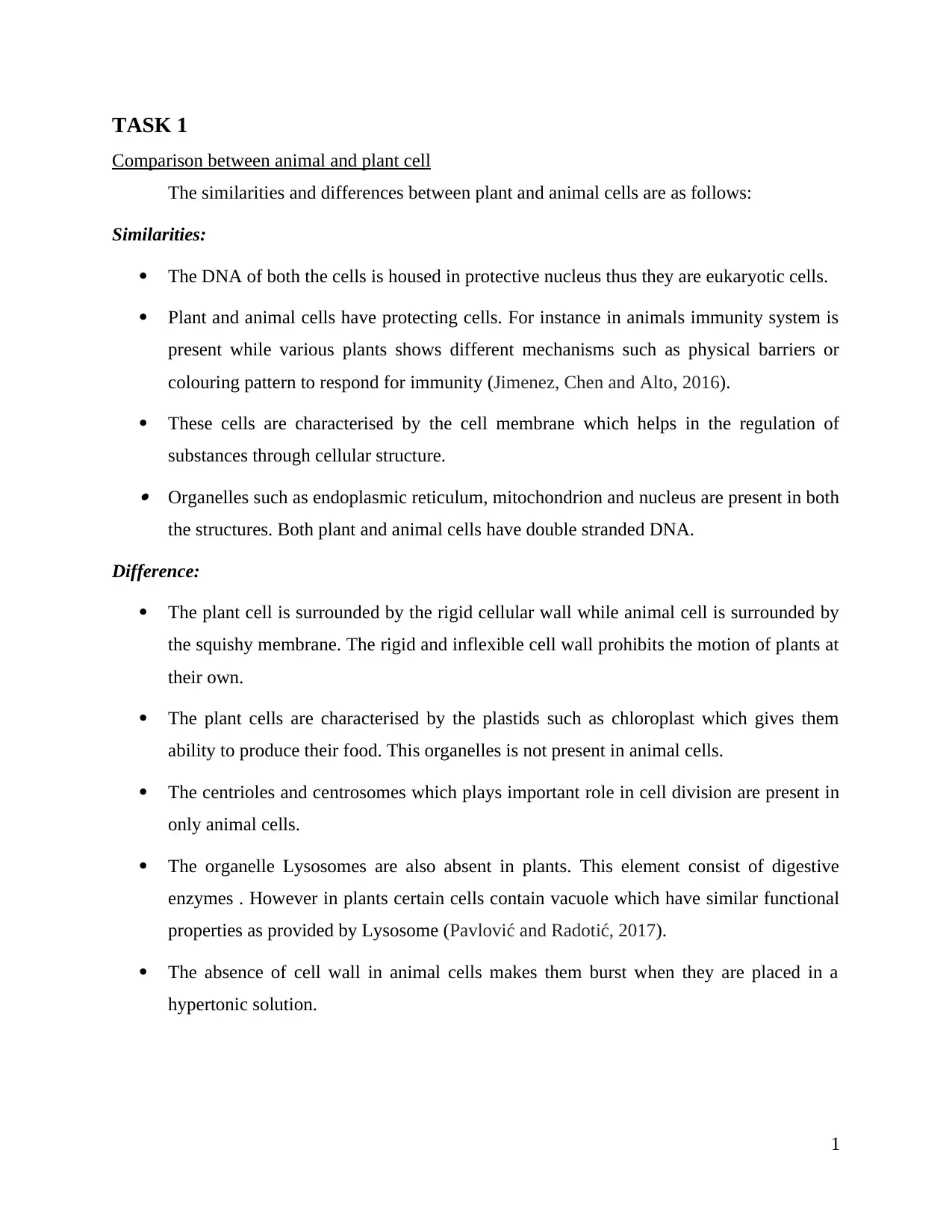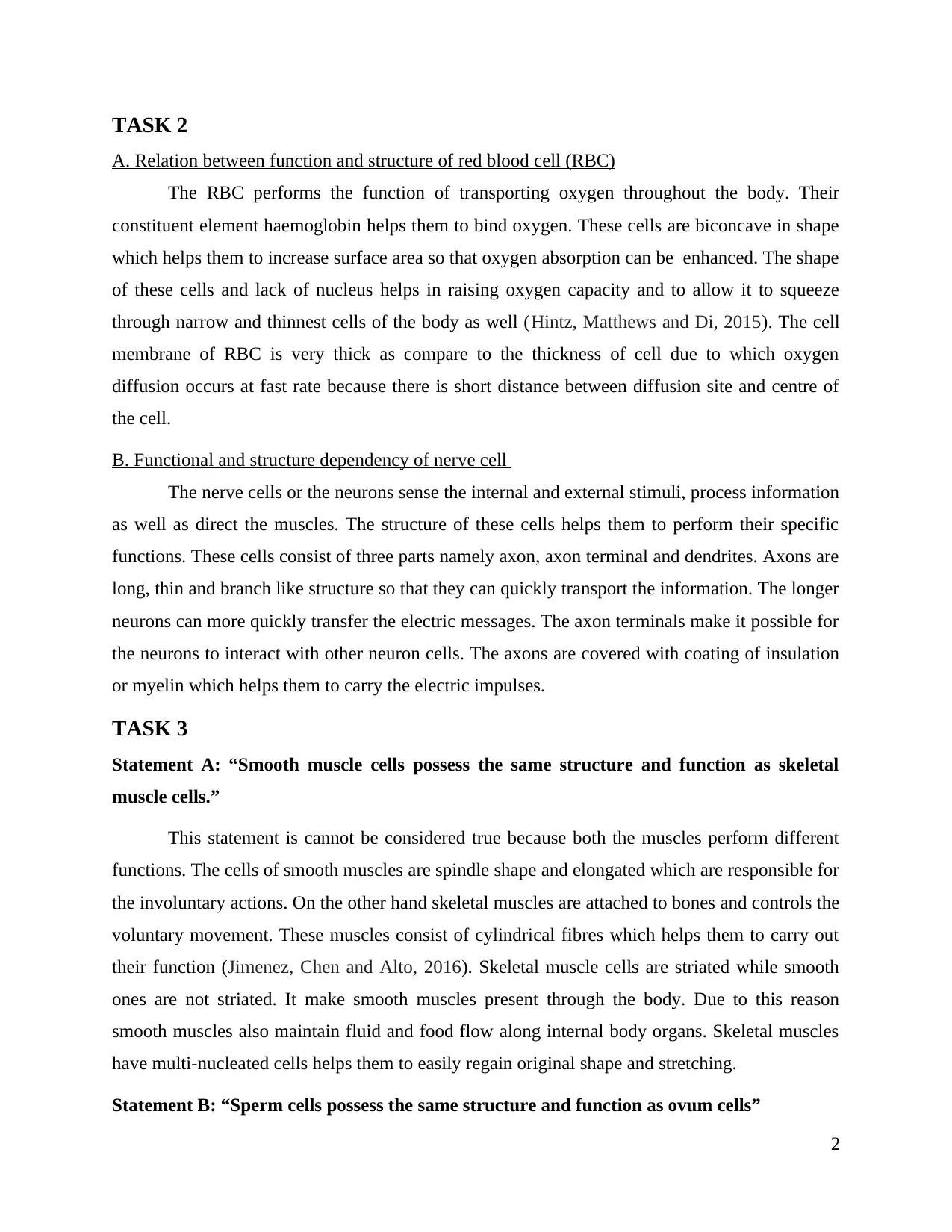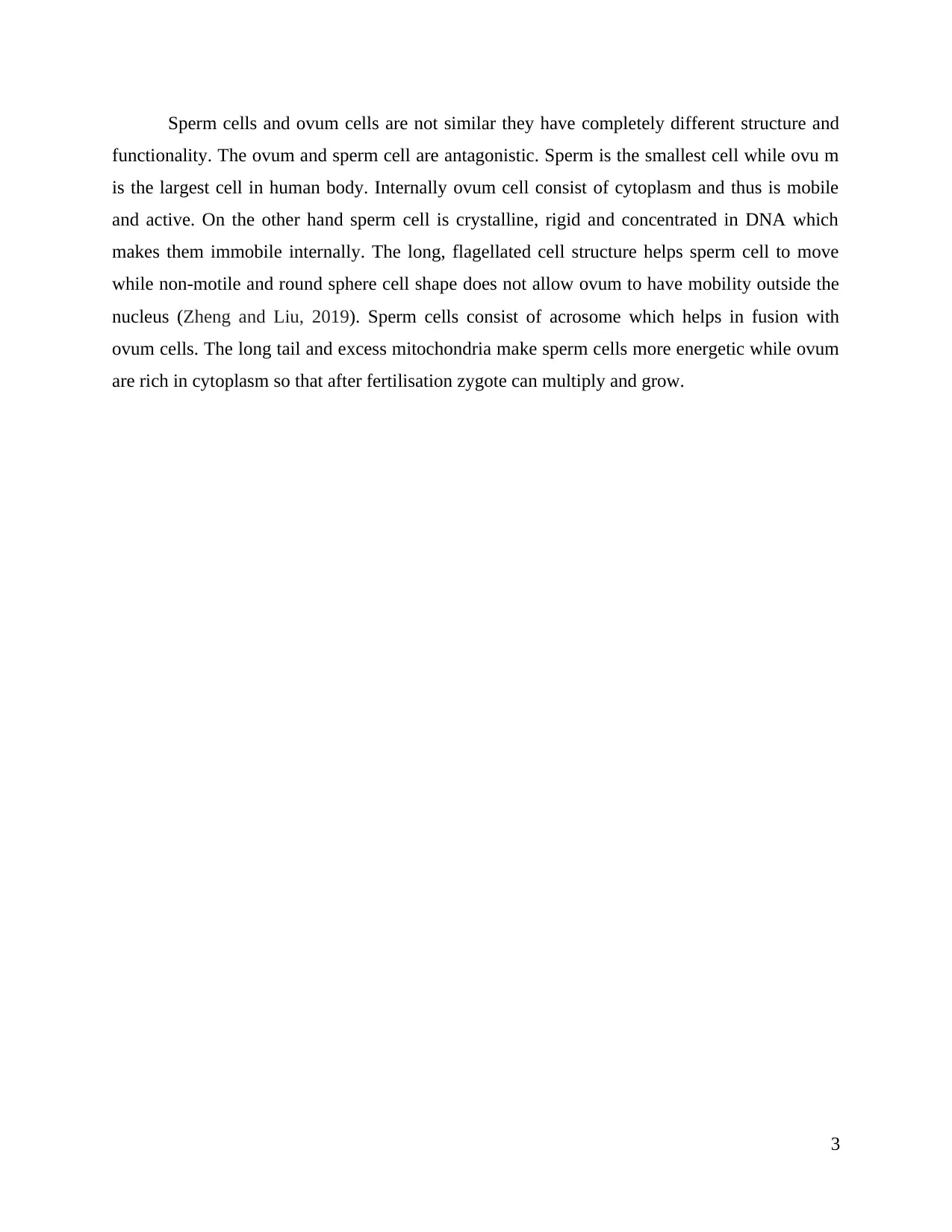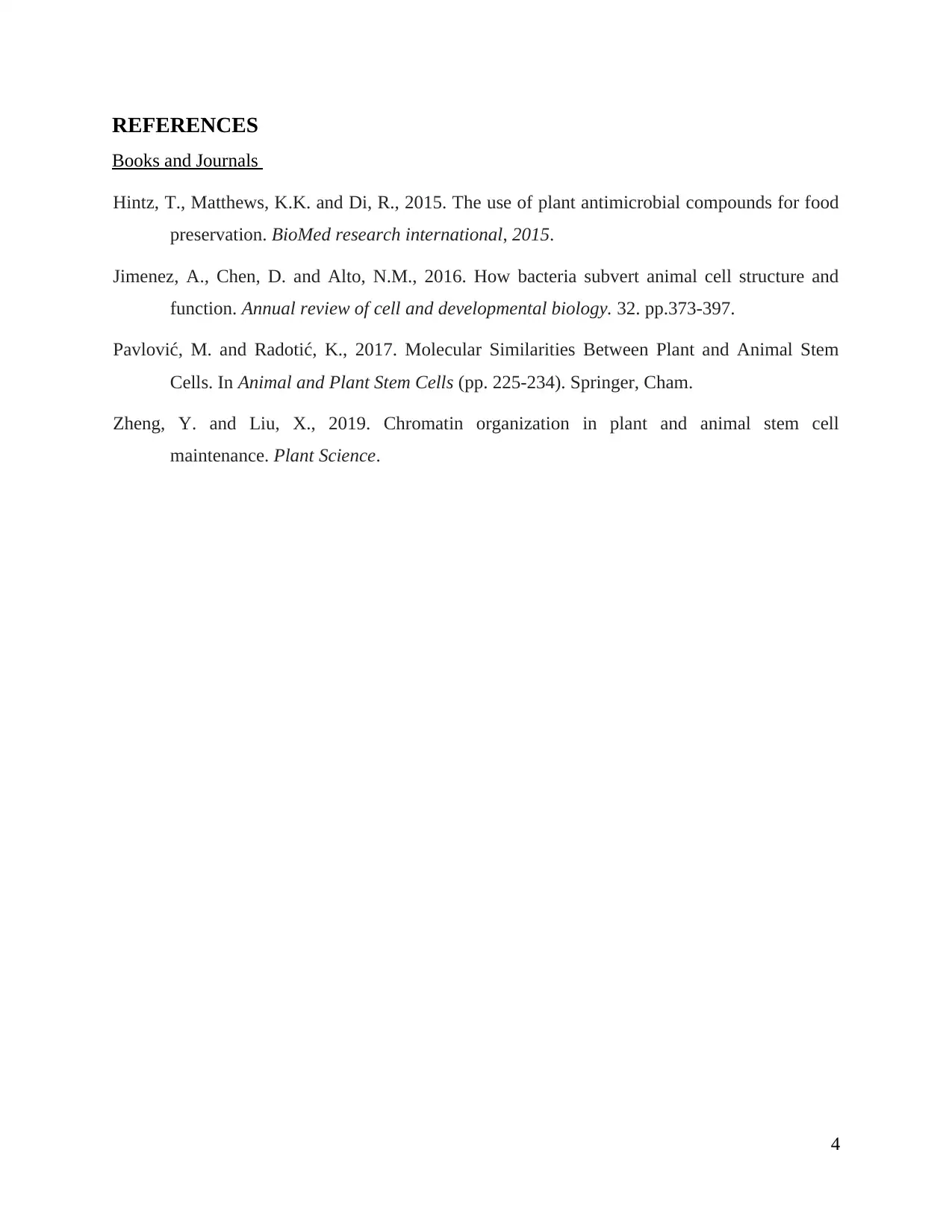University Biology: Cell Research Project - Cell Types and Functions
VerifiedAdded on 2020/10/22
|6
|1022
|330
Homework Assignment
AI Summary
This biology assignment is a cell research project that delves into the comparison of animal and plant cells. It highlights similarities like the presence of a nucleus and cell membrane, while differentiating based on the presence of cell walls, plastids, and centrioles. The project further examines the structure-function relationship in red blood cells, emphasizing how their biconcave shape and lack of a nucleus optimize oxygen transport. Additionally, it explores the structure and function of nerve cells, detailing the roles of axons, dendrites, and axon terminals in transmitting information. The assignment also evaluates statements about smooth and skeletal muscle cells, as well as sperm and ovum cells, clarifying their structural and functional differences. References to relevant scientific literature are also included.

Science - Cell research project
Paraphrase This Document
Need a fresh take? Get an instant paraphrase of this document with our AI Paraphraser

TABLE OF CONTENTS
TASK 1............................................................................................................................................1
Comparison between animal and plant cell................................................................................1
TASK 2............................................................................................................................................2
A. Relation between function and structure of red blood cell (RBC).........................................2
B. Functional and structure dependency of nerve cell ...............................................................2
TASK 3 ...........................................................................................................................................2
REFERENCES ...............................................................................................................................4
TASK 1............................................................................................................................................1
Comparison between animal and plant cell................................................................................1
TASK 2............................................................................................................................................2
A. Relation between function and structure of red blood cell (RBC).........................................2
B. Functional and structure dependency of nerve cell ...............................................................2
TASK 3 ...........................................................................................................................................2
REFERENCES ...............................................................................................................................4

TASK 1
Comparison between animal and plant cell
The similarities and differences between plant and animal cells are as follows:
Similarities:
The DNA of both the cells is housed in protective nucleus thus they are eukaryotic cells.
Plant and animal cells have protecting cells. For instance in animals immunity system is
present while various plants shows different mechanisms such as physical barriers or
colouring pattern to respond for immunity (Jimenez, Chen and Alto, 2016).
These cells are characterised by the cell membrane which helps in the regulation of
substances through cellular structure. Organelles such as endoplasmic reticulum, mitochondrion and nucleus are present in both
the structures. Both plant and animal cells have double stranded DNA.
Difference:
The plant cell is surrounded by the rigid cellular wall while animal cell is surrounded by
the squishy membrane. The rigid and inflexible cell wall prohibits the motion of plants at
their own.
The plant cells are characterised by the plastids such as chloroplast which gives them
ability to produce their food. This organelles is not present in animal cells.
The centrioles and centrosomes which plays important role in cell division are present in
only animal cells.
The organelle Lysosomes are also absent in plants. This element consist of digestive
enzymes . However in plants certain cells contain vacuole which have similar functional
properties as provided by Lysosome (Pavlović and Radotić, 2017).
The absence of cell wall in animal cells makes them burst when they are placed in a
hypertonic solution.
1
Comparison between animal and plant cell
The similarities and differences between plant and animal cells are as follows:
Similarities:
The DNA of both the cells is housed in protective nucleus thus they are eukaryotic cells.
Plant and animal cells have protecting cells. For instance in animals immunity system is
present while various plants shows different mechanisms such as physical barriers or
colouring pattern to respond for immunity (Jimenez, Chen and Alto, 2016).
These cells are characterised by the cell membrane which helps in the regulation of
substances through cellular structure. Organelles such as endoplasmic reticulum, mitochondrion and nucleus are present in both
the structures. Both plant and animal cells have double stranded DNA.
Difference:
The plant cell is surrounded by the rigid cellular wall while animal cell is surrounded by
the squishy membrane. The rigid and inflexible cell wall prohibits the motion of plants at
their own.
The plant cells are characterised by the plastids such as chloroplast which gives them
ability to produce their food. This organelles is not present in animal cells.
The centrioles and centrosomes which plays important role in cell division are present in
only animal cells.
The organelle Lysosomes are also absent in plants. This element consist of digestive
enzymes . However in plants certain cells contain vacuole which have similar functional
properties as provided by Lysosome (Pavlović and Radotić, 2017).
The absence of cell wall in animal cells makes them burst when they are placed in a
hypertonic solution.
1
⊘ This is a preview!⊘
Do you want full access?
Subscribe today to unlock all pages.

Trusted by 1+ million students worldwide

TASK 2
A. Relation between function and structure of red blood cell (RBC)
The RBC performs the function of transporting oxygen throughout the body. Their
constituent element haemoglobin helps them to bind oxygen. These cells are biconcave in shape
which helps them to increase surface area so that oxygen absorption can be enhanced. The shape
of these cells and lack of nucleus helps in raising oxygen capacity and to allow it to squeeze
through narrow and thinnest cells of the body as well (Hintz, Matthews and Di, 2015). The cell
membrane of RBC is very thick as compare to the thickness of cell due to which oxygen
diffusion occurs at fast rate because there is short distance between diffusion site and centre of
the cell.
B. Functional and structure dependency of nerve cell
The nerve cells or the neurons sense the internal and external stimuli, process information
as well as direct the muscles. The structure of these cells helps them to perform their specific
functions. These cells consist of three parts namely axon, axon terminal and dendrites. Axons are
long, thin and branch like structure so that they can quickly transport the information. The longer
neurons can more quickly transfer the electric messages. The axon terminals make it possible for
the neurons to interact with other neuron cells. The axons are covered with coating of insulation
or myelin which helps them to carry the electric impulses.
TASK 3
Statement A: “Smooth muscle cells possess the same structure and function as skeletal
muscle cells.”
This statement is cannot be considered true because both the muscles perform different
functions. The cells of smooth muscles are spindle shape and elongated which are responsible for
the involuntary actions. On the other hand skeletal muscles are attached to bones and controls the
voluntary movement. These muscles consist of cylindrical fibres which helps them to carry out
their function (Jimenez, Chen and Alto, 2016). Skeletal muscle cells are striated while smooth
ones are not striated. It make smooth muscles present through the body. Due to this reason
smooth muscles also maintain fluid and food flow along internal body organs. Skeletal muscles
have multi-nucleated cells helps them to easily regain original shape and stretching.
Statement B: “Sperm cells possess the same structure and function as ovum cells”
2
A. Relation between function and structure of red blood cell (RBC)
The RBC performs the function of transporting oxygen throughout the body. Their
constituent element haemoglobin helps them to bind oxygen. These cells are biconcave in shape
which helps them to increase surface area so that oxygen absorption can be enhanced. The shape
of these cells and lack of nucleus helps in raising oxygen capacity and to allow it to squeeze
through narrow and thinnest cells of the body as well (Hintz, Matthews and Di, 2015). The cell
membrane of RBC is very thick as compare to the thickness of cell due to which oxygen
diffusion occurs at fast rate because there is short distance between diffusion site and centre of
the cell.
B. Functional and structure dependency of nerve cell
The nerve cells or the neurons sense the internal and external stimuli, process information
as well as direct the muscles. The structure of these cells helps them to perform their specific
functions. These cells consist of three parts namely axon, axon terminal and dendrites. Axons are
long, thin and branch like structure so that they can quickly transport the information. The longer
neurons can more quickly transfer the electric messages. The axon terminals make it possible for
the neurons to interact with other neuron cells. The axons are covered with coating of insulation
or myelin which helps them to carry the electric impulses.
TASK 3
Statement A: “Smooth muscle cells possess the same structure and function as skeletal
muscle cells.”
This statement is cannot be considered true because both the muscles perform different
functions. The cells of smooth muscles are spindle shape and elongated which are responsible for
the involuntary actions. On the other hand skeletal muscles are attached to bones and controls the
voluntary movement. These muscles consist of cylindrical fibres which helps them to carry out
their function (Jimenez, Chen and Alto, 2016). Skeletal muscle cells are striated while smooth
ones are not striated. It make smooth muscles present through the body. Due to this reason
smooth muscles also maintain fluid and food flow along internal body organs. Skeletal muscles
have multi-nucleated cells helps them to easily regain original shape and stretching.
Statement B: “Sperm cells possess the same structure and function as ovum cells”
2
Paraphrase This Document
Need a fresh take? Get an instant paraphrase of this document with our AI Paraphraser

Sperm cells and ovum cells are not similar they have completely different structure and
functionality. The ovum and sperm cell are antagonistic. Sperm is the smallest cell while ovu m
is the largest cell in human body. Internally ovum cell consist of cytoplasm and thus is mobile
and active. On the other hand sperm cell is crystalline, rigid and concentrated in DNA which
makes them immobile internally. The long, flagellated cell structure helps sperm cell to move
while non-motile and round sphere cell shape does not allow ovum to have mobility outside the
nucleus (Zheng and Liu, 2019). Sperm cells consist of acrosome which helps in fusion with
ovum cells. The long tail and excess mitochondria make sperm cells more energetic while ovum
are rich in cytoplasm so that after fertilisation zygote can multiply and grow.
3
functionality. The ovum and sperm cell are antagonistic. Sperm is the smallest cell while ovu m
is the largest cell in human body. Internally ovum cell consist of cytoplasm and thus is mobile
and active. On the other hand sperm cell is crystalline, rigid and concentrated in DNA which
makes them immobile internally. The long, flagellated cell structure helps sperm cell to move
while non-motile and round sphere cell shape does not allow ovum to have mobility outside the
nucleus (Zheng and Liu, 2019). Sperm cells consist of acrosome which helps in fusion with
ovum cells. The long tail and excess mitochondria make sperm cells more energetic while ovum
are rich in cytoplasm so that after fertilisation zygote can multiply and grow.
3

REFERENCES
Books and Journals
Hintz, T., Matthews, K.K. and Di, R., 2015. The use of plant antimicrobial compounds for food
preservation. BioMed research international, 2015.
Jimenez, A., Chen, D. and Alto, N.M., 2016. How bacteria subvert animal cell structure and
function. Annual review of cell and developmental biology. 32. pp.373-397.
Pavlović, M. and Radotić, K., 2017. Molecular Similarities Between Plant and Animal Stem
Cells. In Animal and Plant Stem Cells (pp. 225-234). Springer, Cham.
Zheng, Y. and Liu, X., 2019. Chromatin organization in plant and animal stem cell
maintenance. Plant Science.
4
Books and Journals
Hintz, T., Matthews, K.K. and Di, R., 2015. The use of plant antimicrobial compounds for food
preservation. BioMed research international, 2015.
Jimenez, A., Chen, D. and Alto, N.M., 2016. How bacteria subvert animal cell structure and
function. Annual review of cell and developmental biology. 32. pp.373-397.
Pavlović, M. and Radotić, K., 2017. Molecular Similarities Between Plant and Animal Stem
Cells. In Animal and Plant Stem Cells (pp. 225-234). Springer, Cham.
Zheng, Y. and Liu, X., 2019. Chromatin organization in plant and animal stem cell
maintenance. Plant Science.
4
⊘ This is a preview!⊘
Do you want full access?
Subscribe today to unlock all pages.

Trusted by 1+ million students worldwide
1 out of 6
Related Documents
Your All-in-One AI-Powered Toolkit for Academic Success.
+13062052269
info@desklib.com
Available 24*7 on WhatsApp / Email
![[object Object]](/_next/static/media/star-bottom.7253800d.svg)
Unlock your academic potential
Copyright © 2020–2025 A2Z Services. All Rights Reserved. Developed and managed by ZUCOL.





